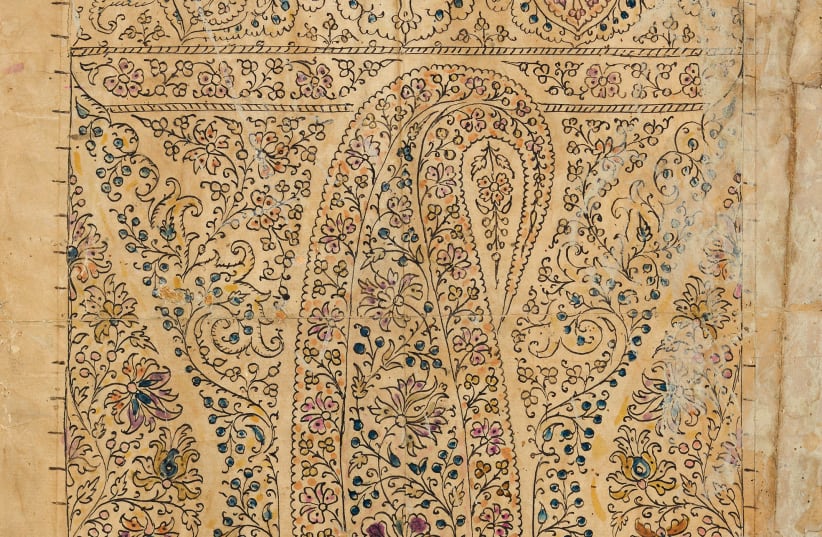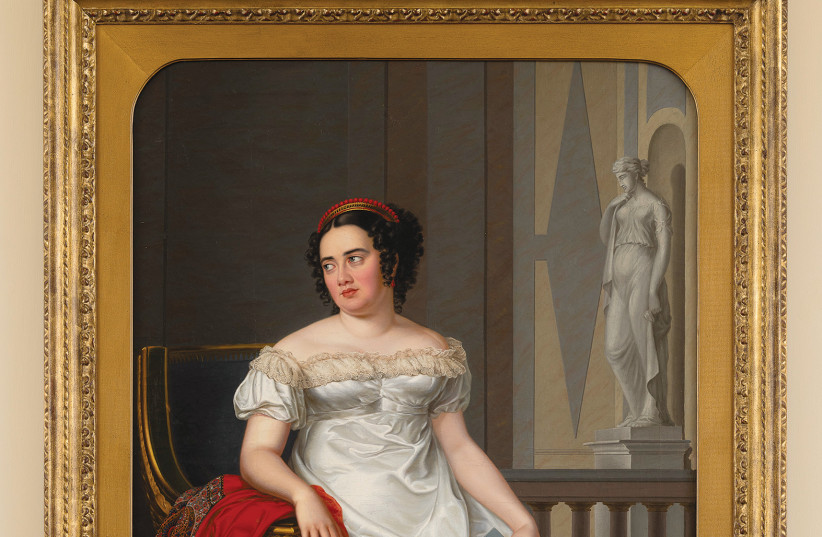Anyone out there old enough to remember wearing a paisley shirt? That was a sartorial invention of the wild woolly and totally groovy Sixties, right? Wrong!
And just in case you think I may be getting my facts a little discombobulated here, I suggest you pop along to the Museum for Islamic Art where, as of last Thursday, you can view the Paisley: A Princely Pattern exhibition. In English that makes for a nicely alliterative, and exegetic, moniker.
It also comes to the rescue of what can only be a pretty nonsensical one-for-one version of the Hebrew title, “MiNesich Ve’ad Prince,” which would translate as: From Prince to Prince. The former refers to the royal position while the latter references the late rock star, which just about spans the full cultural and chronological spectrum of the show.
Now that we’ve put the semantics to rest we can dig into the visual content on display, and the artifact rollout is truly a feast for the eyes, mind and heart.
The exhibit
For starters, we get the lowdown on the origin of the shape, and the historical time bracket in which it emerged as a popular and, later, funky design feature. Then again, there seems to be some debate over the former.
We are told that most scholars believe the paisley design derives from the shape of the cypress tree, specifically in respect of the tendency of the crown to tilt with the wind, hence the skewed teardrop shape.
“The origin of the motif is from Persia,” explains Naama Brosh, who did a fine job curating the exhibition at the museum on Palmach Street.
However, it seems there has been some cultural wrangling going on, for some time, over the inspiration for the enduringly popular motif. “At the Paisley Museum, and in Europe, based on the research carried out they believe the source is the palmette, the palm tree,” Brosh notes. This may be just another example of the old world-new world divide.
The curator says she and her colleagues opted for the Middle Eastern take. “In Iran, the research they did there shows the cypress as the model for the paisley shape.”
Historical and religious factors come into this equation. “In Iran the cypress is holy,” Brosh explains. “Most scholars believe the paisley design comes from the cypress tree whose crown bends in the wind.
“Zoroastrianism, the official religion of ancient Persia from the 5th century BCE to the Arab conquest of the 7th century CE, attached great holiness to the cypress.”
There are all sorts of charming tales associated with the traditional line, as the motif was adopted by Islamic society too. The cypress had a lot going for it, and plenty to offer the marketing movers and shakers of yore. Brosh says the tree’s attributes made it a perfect choice for across-the-board branding.
“It was evergreen – immortal, lived long – eternal, tall – as a great personage, upright – like one who walks a straight path, and strong. The cypress appears with these characteristics in Persian literature, poetry and the arts, and is perceived as the Tree of Life.”THE PAISLEY or boteh – bush – design in Iran really took off during the Qajar dynasty, which began in 1785 and survived through to 1925. The Persian rulers of the day embraced modernity while maintaining a firm grip on their cultural roots – not a bad arboreal philosophy to follow. They were open to the West, and the assimilation of technology and European progress, but were also keen to revive the cultures of the ancient Persian empires and, in particular, the ancient iconography expressed in different forms of art.
Thus, the paisley-boteh shape was adopted by the Qajars as a royal symbol used in their crowns, clothing and various accessories. Paintings created at the time portray the shah, courtiers and the women of the harem, all resplendent in robes, coats and dresses with sumptuous brocades decorated with the boteh design.
“That came into vogue sometime around the 18th century,” says Brosh, adding that they really went for broke. “They began to decorate all the exclusive fabrics with the motif – brocades and their crowns. Just look at this,” she exclaims, pointing to a simply gorgeous watercolor painting that, in fact, dates from the 19th century, and was made in Kashmir in northwest India.
The boteh shape was incorporated by artists of the Muslim Mughal dynasty in India as early as the 16th century CE. The Indian rulers of the day had roots in Persia, so the motif enjoyed a smooth transition to the Far East.
Just as music and other art forms tend to take on local cultural baggage, in India the paisley pattern was believed to derive from the shape of the mango, with the term “kalka” referencing both the design and the fruit. The mango was regarded as “the king of fruits” and, as such, symbolized life, prosperity and happiness, and is associated with Buddha.
THERE IS so much to marvel at across the exhibition spread. Colorful, sumptuous, delightful, eye-catching and delectable are just some of the epithets that sprang to mind as I did the rounds with Brosh. One such is a medallion with a watercolor portrait of the Qajar ruler Naser al-Din Shah who ruled Iran in the latter part of the 19th century. The boteh serves as the highly prominent centerpiece of the handsome bearded gent’s crown. There are also mouthwatering golden turban pins, from 19th century India, encrusted with gemstones among the exhibits.
And if that lot doesn’t get you swooning, the boteh-shaped necklace and earrings, made of gold, gemstones and enamel, from 19th century northern India, should do the trick. Those folks really knew how to live, and how to strut their riches.
The paisley symbol – apropos, the name derives from the Scottish town, near Glasgow, where the first manufacturing plant in Europe for the design was located – eventually sprouted wings and was joyfully embraced by the Who’s Who of the Western world. That, basically, meant anyone with the necessary wherewithal who wanted to be perceived as walking the sunny side of the higher societal street. “The boteh became a sought-after brand,” states Brosh.
The East-West interface, and the Western world’s hankering for any artifact with the motif, is conveyed succinctly in a painting made in India in 1840. The evocative scene depicts Sultan Bahadur Shah II receiving a British India Company official. The Indian royal and his courtiers are dressed in polychromic attire with the boteh front and center, while their British guests display a rather more conservative, and monochromic, dress sense.
Another portrait in the exhibition, by early 19th century German painter Johann Jakob Becker, shows a well-to-do lady, thought to be Eva Hanau von Rothschild, seated on a regal-looking chair with a grand paisley-designed shawl hanging nonchalantly off one of the armrests.
The splendiferous piece of fabric may have been brought over to Germany from any of numerous locations where top-quality materials, carpets, rugs, various items of clothing, and jewelry, were produced with the boteh shape in full enticing view. India, in particular, Kashmir was a major source of such motif-based items.
“In the late 18th century-early 19th century, if you used the term paisley that meant the Kashmir shawl,” says Brosh. “The majority of the shawls at the time were of that design,” she notes, adding yet another anecdotal spice to the paisley tale.
“In Kashmir, they called it botah, not boteh. In the Kashmir language, botah means flower.” Indeed, floral sentiments and motifs abounded back then, and continued to hold their fashionable own for many years.
Presumably, the cause of Western European marketers and importers was helped by the fact that the paisley shape was also adopted by Christians, as early as the Byzantine Era of the 6th-7th centuries CE. The lead motif was perceived by Christians as a symbolic representation of the Tree of Life, and associated it with the crucifixion.
The design proved to be a robust item, surviving the passage of time and political upheavals. From the mid-18th century through to Indian independence, in 1947, Kashmir, the world’s leading paisley weaving center, was ruled by three different dynasties but still managed to maintain its popularity. Naturally, over time technology left its imprint on the manufacturing process with, for example, embroidered shawls becoming a fast track and less expensive option for suppliers and consumers alike.
Jewish communities in Islamic countries also adopted the boteh design as a sought-after symbol. For Jews, the paisley was not just a fashion statement, it found its way into the realms of Judaica. In Iran, Afghanistan, Pakistan and India it appears on sacred and ritual items, such as Torah finials, the parochet – the curtain of the holy ark – garments worn by rabbis, kiddush cups, and fabrics and jewelry used at leading life-cycle events, in particular wedding ceremonies.
The paisley design’s public profile fluctuated for a while, and eventually came into its own as part of the 1960s counterculture. That was, no doubt, helped by the developing trend of hippies and similarly-minded folk, who began to explore Eastern philosophies and art, and found their way to the Indian subcontinent and North Africa.
The likes of the Beatles and rock guitar god Jimi Hendrix were seen sporting paisley shirts, and even our very own Arik Einstein got in on the act. The final exhibition space displays a couple of record covers, including Einstein’s 1968 release Mazal Gdi (Capricorn) with the iconic singer wearing a vest with something akin to a paisley design.
Stellar rocker Prince, albeit a later commercial music pantheon member, also adopted the design, while a striking print from a 2021 demonstration shows protesters wearing red bandanas adorned with the timeless motif.
A video clip with preeminent Israeli rock and pop expert Yoav Kutner enlightens museum visitors with some of the thinking, and undercurrents, that informed the flower power era and led to the widespread acceptance of the paisley aesthetic.
And there is a delightful shot of a middle-aged couple in Ukraine, in 2008, decked out in their robes in a cozy domestic vignette. The husband’s robe has a neo-paisley design. Ukrainian-born photographer Ania Krupiakiv’s photograph captures the essence of ordinariness in a fitting denouement to a design that has done the socioeconomic, political, cultural and temporal rounds across the millennia. ❖
Paisley: A Princely Pattern closes in April 2023.
For more information: www.islamicart.co.il/english/

